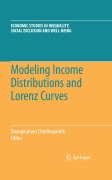
The parameterization of income distributions using Lorenz Curves is a useful technique to analyze the characteristics of income inequality within a given population. It provides a way of describing how data are generated, why the level of inequality is what it is, and how these factors impact poorer sections of the population. This book brings together classic papers in the field, including Camilo Dagum’s most influential contribution, survey papers outlining thestate-of-the-art of the field, and cutting-edge research contributions. Whileproviding a thorough overview of the methodology of income distribution modeling, the book emphasizes its relevance on development economics and its importance for policy makers who design and assess poverty alleviation and income redistribution policies. INDICE: From the contents Part A Collections of Influential Papers: A New Model of Personal Income Distribution: Specification and Estimation. A Function for the Size Distribution of Incomes. Some Generalized Functions for the Size Distribution of Income. Efficiency Estimation of the Lorenz Curve and Associated Inequality Measures from Grouped Observations. Distribution and Mobility of Wealth of Nations.- Part B Survey Papers on Lorenz Functions and the Generalizations and Extensions of Income Distributions: Dagum Distributions. Pareto and Generalized Pareto Models. The Distribution of Income and Estimation of Related Measures of Inequality: the Beta Distribution. Parametric Lorenz Curves:Models and Applications.- Part C Current Research: Maximum Entropy Estimationof Income Distribution Functions from a Relative Gini Coefficient. A New FiveParameter Income Distribution Model. Fuzzy Monetary Poverty Measures under a Dagum Income Distributive Hypotheses.
- ISBN: 978-0-387-72756-1
- Editorial: Springer
- Encuadernacion: Cartoné
- Páginas: 330
- Fecha Publicación: 01/08/2008
- Nº Volúmenes: 1
- Idioma: Inglés
